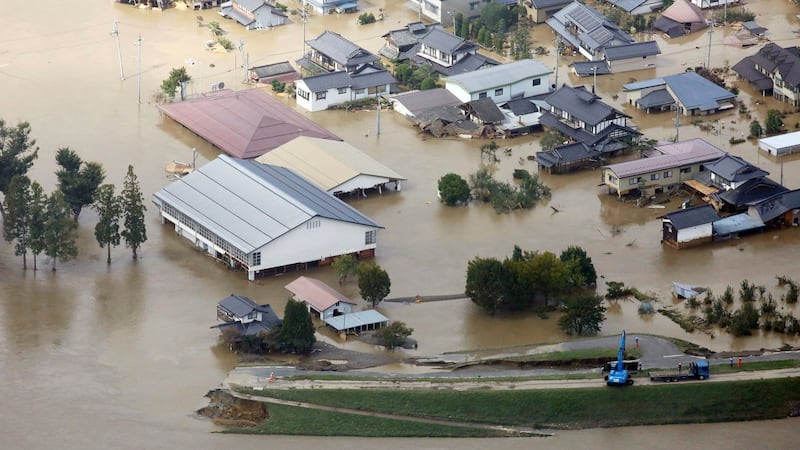At least 33 people have died and many others others are missing after one of the most powerful typhoons in decades struck wide areas of Japan’s main island on Saturday night.
Media reports said thousands of troops, fire-fighters and other emergency workers had been dispatched to rescue people trapped by flood water in the worst-hit areas. Utilities raced to restore power to hundreds of thousands of homes.
Typhoon Hagibis, which has been described by meteorologists as the strongest storm to hit Japan for more than six decades, caused widespread damage across low-lying land in central and eastern parts of the country, with rivers bursting their banks after hours of torrential rain and howling winds.
Hagibis, which means “speed” in the Philippine language Tagalog, forced the cancellation of hundreds of flights and affected shinkansen bullet train services, the Japanese state broadcaster NHK said, reporting that more than 100 people had been injured.
Hagibis also caused disruption to major international sports events scheduled to take place over the three-day weekend, including the Rugby World Cup, forcing the cancellation of several pool matches.
Millions of residents of Tokyo awoke to sunshine and clear skies, and many train lines resumed services. However, authorities warned that rivers in eastern Japan could still overflow and inflict more damage.
Prime minister Shinzo Abe held an emergency meeting and offered his support to all those affected by the disaster – the second destructive storm to hit Japan in the space of a month.
“I extend my condolences to all those who lost their lives and offer my sympathies to all those impacted,” Mr Abe said. “With respect to blackouts, water outage and suspension of transportation services, we will do our utmost to bring about a swift recovery. We ask the public to stay vigilant in case of landslides and other hazards.”
Emergency workers
The government said 27,000 members of the self-defence forces and other emergency workers had been sent to Nagano prefecture – one of the most badly affected regions – and other affected areas to help with the rescue effort.
TV footage showed military helicopters airlifting stranded people from homes that had been flooded by river water. Some families, including those with small children, had been forced to seek safety on their roofs.
One clip showed a helicopter hovering over a flooded area in Nagano prefecture, where an embankment of the Chikuma river had broken and unleashed sheets of water across residential areas. The helicopter plucked those stranded on the second floor of a home submerged in muddy waters.
Aerial footage showed tractors at work trying to control the flooding. Meanwhile, rows of bullet trains were left sitting in a pool of water at a depot.
The operator of the Fukushima Daiichi nuclear power plant, which was wrecked by a deadly tsunami in March 2011, reported irregular readings from sensors monitoring water at the facility.

Emi Iwasa, a spokeswoman for Tokyo Electric Power, said the storm had triggered 11 leak alerts at the plant, eight of which were confirmed as having been caused by rain water. The utility has not confirmed if any radioactive water leaked into the sea.
Away from the plant, a stretch of Fukushima was flooded, with only the rooftops of residential homes visible. Parts of nearby Miyagi prefecture were also under water. The seven-river system, which runs by Tokyo, overflowed its banks.
Authorities at one point issued evacuation advisories and orders for more than 6 million people as the storm unleashed heavy rain and winds.
“The major typhoon has caused immense damage far and wide in eastern Japan,” Yoshihide Suga, the government’s top spokesman, told reporters.
“The water came up higher than my head in the house,” said Hajime Tokuda, a resident of Kawasaki, near Tokyo.
Warehouses
In Higashimatsuyama city, northwest of Tokyo, rice and flower farmers were counting their losses,water submerging warehouses full of freshly harvested crops.
“We never had a flood like this before in this neighbourhood,” said one farmer, who declined to give his name. “We cannot even go into the flower warehouse due to the water. I don’t know where to start cleaning up this mess.”
Authorities warned of a continuing threat from mudslides. Among the reported deaths were those whose homes had been buried. Other fatalities included people who were swept away by raging rivers.
Mr Suga said damage to housing was extensive, but promised help was on its way.
By Sunday afternoon, more than 160,000 homes were without electricity, the public broadcaster NHK said, adding that about 1,000 people in Chiba, east of Tokyo, were experiencing water shortages.
The widespread loss of electricity has again raised questions about Japan’s power infrastructure, weeks after Typhoon Faxai destroyed or damaged 30,000 houses in Chiba and caused extensive power cuts.
The improvements in safety infrastructure that accompanied Japan’s post-war modernisation were apparent, however. The authorities had repeatedly warned that Hagibis’s strength was on a par with a typhoon that hit the Tokyo region 61 years ago. That storm, Typhoon Ida, left more than 1,200 people dead and half a million houses flooded.
The Rugby World Cup match between Namibia and Canada, scheduled for Sunday in Kamaishi on the country’s northeast coast, was cancelled. However, a decisive fixture between Japan and Scotland in Yokohama, south of Tokyo, went ahead.
Qualifying for the Japanese Formula One race in Suzuka was pushed back from Saturday to Sunday. – Guardian



